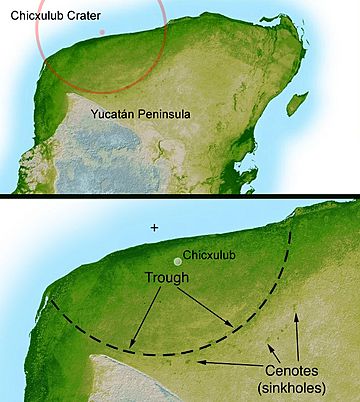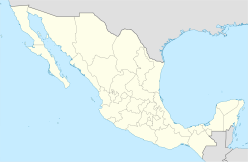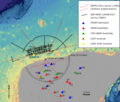Chicxulub crater facts for kids
| Chicxulub impact structure | |

|
|
| Impact crater/structure | |
|---|---|
| Confidence | Confirmed |
| Diameter | 180 km (110 mi) |
| Depth | 20 km (12 mi) |
| Impactor diameter | 10 km (6.2 mi) |
| Age | 66.043 ± 0.043 Ma Cretaceous–Paleogene boundary |
| Exposed | No |
| Drilled | Yes |
| Bolide type | CM or CR type carbonaceous chondrite |
| Location | |
| Coordinates | 21°24′0″N 89°31′0″W / 21.40000°N 89.51667°W |
| Country | Mexico |
| State | Yucatán |
The Chicxulub crater is a giant crater found in the Yucatán Peninsula of Mexico. Part of it is on land, and part is under the sea. Many scientists believe this crater was made by a huge meteor that crashed into Earth. This crash is thought to have caused the extinction of the dinosaurs and many other living things.
The Chicxulub crater is incredibly wide, measuring over 180 kilometers (110 miles) across. This makes it one of the largest confirmed impact craters on Earth. It was first discovered in the late 1970s by people looking for petroleum (oil).
The space rock that created the crater was at least 10 kilometers (6 miles) wide. Scientists found proof of this impact, like special rocks called shocked quartz. They also found tiny glass beads called tektites in the areas around the crater. These form when rock melts from extreme heat and then cools quickly.
A Giant Impact
The rocks and other scientific tests show that this huge impact happened about 66 million years ago. This was at the very end of the Cretaceous period. Many experts agree that this event led to the mass extinction that wiped out the dinosaurs.
In 2010, a group of 41 international experts studied all the information about the crater. They looked at data from fossils, chemistry, climate studies, and geology. They all agreed that the Chicxulub impact caused the mass extinctions. This included the end of the dinosaurs.
Scientists have even drilled into the crater's rocks to learn more. This helps them understand exactly how the asteroid created such a massive hole.
Proof of the Crash
Scientists have found clear evidence of the asteroid impact's effects. For example, in North Dakota, they found fossils of fish and trees. These fossils were covered in rocky, glassy pieces that fell from the sky. These pieces were debris from the impact.
The areas also show signs of being flooded with water. This was caused by a massive tsunami (a giant sea wave) that happened after the asteroid hit the ocean.
Related pages
Images for kids
-
Artistic impression of the asteroid slamming into tropical, shallow seas of the sulfur-rich Yucatán Peninsula in what is today Southeast Mexico. The aftermath of this immense asteroid collision, which occurred approximately 66 million years ago, is believed to have caused the mass extinction of dinosaurs and many other species on Earth. The impact spewed hundreds of billions of tons of sulfur into the atmosphere, producing a worldwide blackout and freezing temperatures which persisted for at least a decade.
See also
 In Spanish: Cráter de Chicxulub para niños
In Spanish: Cráter de Chicxulub para niños







